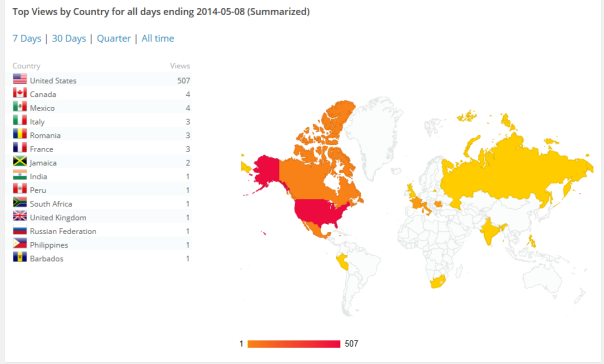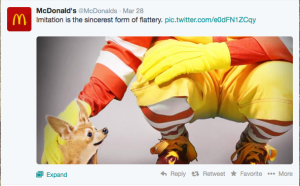Project Review
Objective:
Taken straight from my project proposal, “There is a obesity epidemic in the U.S. and in order for fix this Americans need to become more knowledgeable about nutrition. My goal is to inform people about how to make healthier decision and the tricks food producers use as marketing tactics, as well as promote cooking at home.”
Medium:
I chose a blog because I really like the way that some “internet personalities” are able to create communities through their blogs. The whole set of wikis kind of turned me off because I was not a fan of how they are set up. When I was trying to make a new page it took me like a hour, and let me tell you I am very technology literate and have no problem working with new programs but something about wikis had my mind drawing a blank. The way WordPress has a text box set up with all the links I need is comforting. Furthermore the whole concept of a wiki page always being under construction is not my style at all. It just doesn’t work for me to publish unfinished work.
What I did:
Looking back at my archives I did a lot of posts. At first my goal was to do two long posts of about 800 words and one other smaller one that would be on a popular topic like a new ad or something. For my informative posts I use a style of writing that reminds me of what I would do if I was writing an article. I spend a good amount of time looking at other recent articles and research about the topic, use those articles to find the key information and then bring that all together to create one comprehensive blog posts. Through my post I then link back to the articles that I used as references, for example this post on drinking your calories. I think it is very important I use trustworthy sources for my information. That way my readers can go look at more information and verify what I am saying in my posts.
I wanted to post more about marketing techniques that food producers use. The issue I had with this is that new products or advertisements only come out so often, because of this I could not assume that there was going to be a new topic for me to write about each week.
There was times when I needed to restructure the way that I was working. During April I started posting four times a week because I was not getting the length that I wanted so I compensated by posting more often. I feel like posting often is a good way to direct traffic to your blog and is very important in the initial creation of a blog.
What went not so well?
This wasn’t an issue per se but I found while I was gaining traffic on my blog that I should disclose that I am not a registered dietitian. For each post I spend about two or three hours becoming knowledgeable about a topic, post the important information I have learned, and then share links in order for readers to find out more information themselves. I find myself staying away from some topics and trying to be purely informative about the nutrition posts because I would never want to influence someone to make damaging decisions.
Did I accomplish my objective?
I choose the topics I write about because I want to inform people so that they can live a happy, healthy life. In my objective it may seem I focusing on overweight and obesity issue but that is because being overweight leads to cardiovascular disease, diabetes 2, and some cancers which can all be prevented by living a healthy life. Therefore I simply want to share information about how important it is to have a healthy diet and how you really are what you eat. A cool quote from my project proposal:
“I want to unmask the processed foods industry and help people make better decisions about the products they are consuming.”
Based on that quote I feel like my blog has done this and is continuing to inform people about their food purchasing decision.
Findings?
Partially through this blog I discovered that my true passion is food psychology. I remember this moment like ti was just yesterday. I was, like I am now, sitting at Cantabria looking for topics online through some of my usual sources. Because of my thesis topic also being about food, if you haven’t noticed its my favorite thing, I am familiar with this area of study and have read multiple research papers and articles in this field. One of the major players in this filed, Dr. Brian Wansink, tweeted about research he had conducted about chocolate milk in schools. While reading that article I was strangle fascinated with their findings, partially fueled by coffee, but never the less I was have a great time reading about why schools shouldn’t ban chocolate milk. We are all nerds about something but I feel like my is a partially small niche.
I definitely got better at writing posts as time went on. At first I would struggle to hit 800 words but in my last post I was able to get more than 700 words about whole wheat. Who know so much could be said about whole wheat/whole grain foods? It is extremely important to be passionate about what you are blogging about because you spend hours and hours during the week researching topic and then writing about those topics. So because of this you better really like what your are blogging about otherwise you will get bored and burnt out real quick.
Future?
Initially had in-visioned making a space that is open for dialogues. In my proposal I said, “blog is the perfect medium for my project because it allow me to be more personal with the readers, hopefully create a community, and allow for open communication through comments.” So far I haven’t received many comments on my posts. Maybe the people looking at my blog are just lurkers? I would like to look at information on how to connect with your readers. I would like to learn more about the analytics that WordPress uses in order to find out what type of posts receive the most traffic.
Should You be Eating Whole Wheat or Whole Grain, and Why?
“Whole grains or foods made from them contain all the essential parts and naturally-occurring nutrients of the entire grain seed in their original proportions. If the grain has been processed (e.g., cracked, crushed, rolled, extruded, and/or cooked), the food product should deliver the same rich balance of nutrients that are found in the original grain seed,” as defined by the Whole Grains Council. For instance, regardless of how oats are rolled, cut, or ground during processing, the oat does not lose any of its nutritional content. The three fundamental parts of the kernel is the bran, germ, and endosperm. In order to be considered a whole grain, the food item must contain 100% of the original kernel.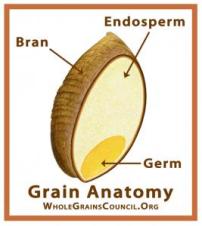
Whole grain is processed to include the whole grain seed, whereas white flour uses only the less nutritious endosperm. By using all parts of the grain whole grain is more nutritious because it has higher levels of fiber, vitamins B6 and E, magnesium, zinc, folic acid and chromium. The majority of which are lost when processing occurs to make white flour. Refining wheat creates fluffy flour that makes light, airy breads and pastries. But nutrition is compromised for the taste of the beloved refined grains. The process strips away more than half of wheat’s B vitamins, 90 percent of the vitamin E, and virtually all of the fiber.
The health benefits of switching from refined to whole grain foods are well established, including lower risk of cardiovascular disease, weight gain, and type 2 diabetes. Based on this evidence, the U.S. Department of Agriculture’s (USDA) 2010 Dietary Guidelines recommend that Americans consume at least three servings of whole grain products daily, and the new U.S. national school lunch standards require that at least half of all grains be whole grain-rich. However, no single standard exists for defining any product as a “whole grain.”
Determining what food items are actually whole gain or whole wheat can be challenging in the grocery store. And then we ask the question: what is the difference between whole grain and whole wheat? The Whole Grains council describes the difference between whole grain and whole wheat as the same difference between a carrot and a vegetable?” We all know that all carrots are vegetables but not all vegetables are carrots. It’s similar with whole wheat and whole grain: Whole wheat is one kind of whole grain, so all whole wheat is whole grain, but not all whole grain is whole wheat.
A meta-analysis of seven major studies showed that cardiovascular disease (heart attack, stroke, or the need for a procedure to bypass or open a clogged artery) was 21 percent less likely in people who ate 2.5 or more servings of whole-grain foods a day compared with those who ate less than 2 servings a week.
The whole grain stamp produced by the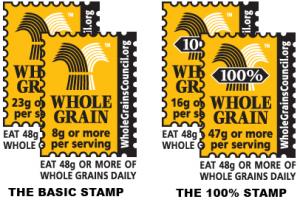 Whole Grain Council started to appear on store shelves in mid-2005. It recently received some criticism from the Harvard School of Public Health.
Whole Grain Council started to appear on store shelves in mid-2005. It recently received some criticism from the Harvard School of Public Health.
A common “Health Halo” is that often times people incorrectly assume that a product that is whole wheat is healthier than one that is not, in every sense. Health claims, in this case whole wheat, on a product can produce a “halo effect” where consumers reported beneficial effects from the product beyond those specifically mentioned in the claim. One healthy attribute leads consumers to assume that foods offer other healthy but unclaimed attributes.
The Harvard School of Public Health “found that grain products with the Whole Grain Stamp, one of the most widely-used front-of-package symbols, were higher in fiber and lower in trans fats, but also contained significantly more sugar and calories compared to products without the Stamp”.
This stamp only relays information about a food items whole grain content. It is not surprising that food producers have to add extra sugars to whole wheat products in order to achieve the taste that consumers demand. Through this study Harvard simply found that just because has one good quality doesn’t equate to the entity of that product being healthy.
The key thing to remember is it must be 100%. At the grocery store, check labels and chose items made with 100 percent whole wheat — meaning it is made with only whole-wheat flour, whereas breads and other things labeled simply “whole-wheat” might contain a mix of whole wheat and white flours. Also as Harvard showed us, be conscious of the sugar content as well.
Weekly Review
Things went pretty well this week. In honor of my thesis, and that being the only thing on my mind, I posted two posts about my nerdy passion, food psychology. This was kind of cheating for me because I had already done plenty of research on the topics but I still spent on a few hours on them reworking things to make it stylized for a blog. Not that it’s obvious or anything but I have a few opinions on food marketing and how it is affecting the health of consumers. Another not so obvious thing, I’m pretty quiet but if you feel like letting me talk your ear off for an hour just ask my opinion on low-fat.
Initially I was only going to do one post about my thesis topic, which quickly escalated to being very long so I broke it down into sections. First I started out with some history about processed food in order to provide some background and understanding of why things are the way they are now. Then I moved onto the marketing of processed foods and how that affects consumers purchasing decisions. After that I introduced the theory the “Health Halo” effect. This post brings everything all together and looks at how processed food and the marketing of it affects us psychology when we consume these products. To end the week on a lighter note I did a post on hummus because it is delicious and I missed doing posts about food.
4/23 Process Food Through the Years
4/25 Marketers Use Words to Influence the Way You Think About Food
4/25 “Health Halo” Effect
4/28 Hummus, the New Nutrient Rich Spread
I am the only nerd out there that is so interested in food psychology. Speaking of nerding out I have to highlight this post I did two ago about chocolate milk, Banning Chocolate Milk Doesn’t Have Outcomes Parents Hope For. This new study was pretty interesting and I had a fabulous time reading it while sipping on some coffee in Cantabria with my laptop that’s so old it sounds like a small vacuum when the fan runs.
Hummus, the New Nutrient Rich Spread
No one knows for sure how far back the history of hummus goes, but traces of chickpea, the key ingredient, have turned up in Middle Eastern archeological sites dating to 7,500 B.C. Made from the few ingredients of chickpeas (garbanzo beans), olive oil, lemon juice and salt hummus is a delectable, creamy, irresistibly tasty spread. Seasonings are added to taste and can be used to make different varieties like roasted pepper, roasted garlic, or stick with traditional and sprinkle some cumin on top. The making of this dish is quite simple. All the ingredients are simply ground down until they form a smooth paste. These key ingredients come together beautifully and create a snack that is chock-full of nutrients that are linked to many health benefits.
 Hummus is a great sources of Omega 3 fatty acids, iron, and fiber. Beyond the nutritious benefits hummus is very satiating as well as rich in protein which helps you fight hunger cravings. “Food satiety” is the scientific term used to describe our satisfaction with food—how full it leaves us feeling, and how effective it is in eliminating our sense of hunger and appetite. Hummus can lower your risk of heart disease because it supports healthy cholesterol and blood pressure. These nutrients also contribute to better regulation of blood sugar.
Hummus is a great sources of Omega 3 fatty acids, iron, and fiber. Beyond the nutritious benefits hummus is very satiating as well as rich in protein which helps you fight hunger cravings. “Food satiety” is the scientific term used to describe our satisfaction with food—how full it leaves us feeling, and how effective it is in eliminating our sense of hunger and appetite. Hummus can lower your risk of heart disease because it supports healthy cholesterol and blood pressure. These nutrients also contribute to better regulation of blood sugar.
In a recent study, “two groups of participants received about 28 grams of fiber per day. But the two groups were very different in terms of their food sources for fiber. One group received dietary fiber primarily from garbanzo beans. The other group obtained dietary fiber from entirely different sources. The garbanzo bean group had better blood fat regulation, including lower levels of LDL-cholesterol, total cholesterol, and triglycerides.”
The base of hummus is garbanzo beans. Known by many names garbanzo beans are also commonly called chickpeas. The name “chickpea” can be traced back through the French chiche, Latin for ‘chickpea’. When found in the grocery store the name chickpeas and garbanzo beans are interchangeable, elsewhere there is subtle differences between the two. The beans found in grocery stores are usually cream-colored and relatively round, known at the “kabuli-type”. These beans come in many variety’s. World wide the most common type of garbanzo been is the “desi-type” which is smaller, irregularly shaped, and varies in color.
Hummus’ popularity is on the rise because Americans are seeking more “healthy” snacks. The sales of these types of spreads have gone up to $530 million in 2012, a 11 percent increase from a year earlier and a 25 percent jump over 2010, according to market-research firm Information Resources Inc. Grocery isles have been filling up with many different brands of pre-made hummus. Since this dish is so simply to make I highly suggest making it at home, which will also be more cost effective and you won’t have to worry about preservatives.
“Health Halo” Effect
As rates of overweight and obese Americans have reached record-levels, advertising claims have become more common on the fronts of food packaging, creating concerns that they may lead consumers to see foods as healthier than they really are (Brownell & Horgen, 2004; Nestle, 2002; Pomeranz, 2001). The effects of marketing can be significant because nutrition claims made on packaging can create “health halos” that make foods appear healthier than they are, leading to higher consumption yet lower perceived calorie intake. It is important to understand that influence of nutrition claims (e.g. “low fat”, “high fiber”) on health-related judgments and decisions. The effects of health claims on packaging is seen in a study done by Wansink and Chandon (2006) found that labeling both “healthy” and “unhealthy” food as “low fat” reduced calorie estimation by 20%-25%, and increased what was considered to be the “appropriate serving size” by 20%.
Chandon and Wansink introduced the “health halo” effect in 2007, referring to the findings that people tend to underestimate the calorie content of foods in restaurants where food choices are advertised as healthy, compared to restaurants that do not advertise a health image. One healthy attribute leads consumers to assume that foods offer other healthy but unclaimed attributes. Health claims on a product can produce a “halo effect” where consumers reported beneficial effects from the product beyond those specifically mentioned in the claim. This shows that the way consumers are processing the information they seeing on packages is far more complex than them simply processing it, they use their own beliefs and ideas and therefor interpret the information in a different way than it may be presented. For instance many consumers may mistakenly think that low fat equates to low calorie.
The mere presence of a low-fat claim has been shown to lead to underestimation of calories and greater consumption (Wansink and Chandon 2006). In a study products with a half-the-fat claim and half-the-calorie claim 22 percent of the participants made a positive “health halo” inference and thought the product was “healthy” or “good for you.” Though the study found that the products that claimed to be “better-for-you” tended to be “healthier”. But this is not to say that “healthier” is synonymous with “healthy”.
“Labeling snacks as low fat increases food intake during a single consumption occasion by up to 50%. This is robust across both hedonic utilitarian snacks, across young and old consumers across self-reported nutrition experts and novices, in public and private consumption, and regardless of whether people serve themselves or not” Wansink and Chandon 2006.
Studies by Wanskin and Chandon 2006 suggested that low-fat nutrition claims increase consumption because they increase perception of the appropriate serving size and reduce anticipate consumption guilt. “Health halos influence consumption because people feel that they can eat more of healthy food, or can eat more unhealthy (but tasty) food after eating healthy food without suffering any adverse health consequences” (Ramanathan and Williams 2007).
The effect that marketing can have on consumers purchasing habits is shown in Kellogg’s decision to market its first health claim. In 1984, Kellogg worked with the National Cancer Institute to endorse a health claim for All-Bran cereal, within six months the products market share increased by 47%. Kozup, Cyer, and Burton (2003) showed that “when a heart-healthy claim is on the package or menu, consumers generally judge the product to reduce the likelihood of heart disease or stroke, but favorable nutrition information lead to more positive attitudes toward the product, nutrition, and purchase intentions.” When unfavorable nutrition information is available, the heart-healthy claim has no influence on either the evaluations or disease risk perception.
This overall pattern results suggests that consumers may be somewhat wary of health claims and prefer instead to trust the information contained on the Nutrition Facts panel when it is available. Favorable nutrition information on Nutrition Facts panels have even stronger effects than health claims on product attitude and purchase intentions. Never the less, results showed that there were positive effects of the inclusion of a heart-healthy claim on a package or menu.
Marketers Use Words to Influce the Way You Think About Food
“[At] no point in US history have food products displayed so many symbols and statements proclaiming nutrition and health benefits.” The marketing that companies use on the front of their products in order to sell their goods is important because it reaches consumers at time of purchase and consumption. The amount of new food products, in 2000, that were marked “reduced/low fat”, 2,076 out of 16,890, had peaked at this time. There is a growing concern about nutrition and consumers wanting nutritional information on labels and they want more health food items conveniently available to them, found Nestle and Ludwig.
In the past years, marketers have become increasingly likely to make heavy use of nutrition claim (including “low fat”), health claims, and vague unregulated claims or health sales (“smart choice” or “good for you”). The words that marketers use to explain products can have a profound effect on consumer’s perceived nutrition of the food. There is a rise in the amount of foods claiming to be “better-than-you” because “the message that a food or food component is naturally and intrinsically healthy is one of the most appealing to consumers in all cultures” (Stone 2009).
Almost 70 percent of American adults age 20 or over the a were identified as overweight or obese. What makes obesity so relevant in this century? High body mass index (BMI) among children and adolescents has become and continues to be a major public health concern in the United States because it is the source of so many health issues. Children with high BMI often become obese adults, and obese adults are at risk for many chronic conditions such as diabetes, cardiovascular disease, and certain cancers. The key issue is that the majority of these diseases are preventable. But when people chose their food items, nutrition ranks last in a survey of the drivers of food choices, after taste, cost, and convenience.
This social issue trend can be traced all the way back to the grocery store and restaurants. When one walks down a grocery isle they are bombarded with a variety of products claiming to be healthy for them, whole grain, low-fat, low cholesterol, sugar free, fiber rich, the claims are endless. The decision to purchase processed food products differs from other purchasing decision. This is due to the fact that a health claim present of the front of packaging is typically encounter before nutrition information, which is usually present on the back or side panes, is processed.
Even when consumers are aware of the persuasive intent behind various marketing communication tools, they may not realize that their consumption decisions are being influenced, Chandon, Pierre, and Wansink (2012).
The effects that health claims can have on their perception of a food item can be shown just by the name of the food. The name of the food has a strong influence on how consumers’ expectations of how tasty, filling, or fattening the food will be, which are often uncorrelated with reality. For example, a study showed that branding the same food as a “salad special” versus “pasts special” or as “fruit chews” versus “and chews” increased dieters perceptions of the healthfulness or tastiness of the food as well as its actual consumption. Although, the name changes had no impact on non-dieters. This same effect of wording can be seen in again in that food is perceived to be leaner and higher quality when labeled “75% fat-free” than “25% fat.”
The effect of key words on packaging happens as well in other products who have health claims that do not specifically claim to be low-fat. Andrews, Netermeyer, and Burton (1998) show that consumers falsely infer that foods low in cholesterol are low in fat. Similarly, there is anecdotal evidence that some consumers erroneously believe that low-fat nutrition claim indicate fewer calories (National Institutes of Health 2004).
The effects of marketing can be significant because nutrition claims made on packaging can create “health halos” that make foods appear healthier than they are, leading to higher consumption yet lower perceived calorie intake. It is important to understand that influence of nutrition claims (e.g. “low fat”, “high fiber”) on health-related judgments and decisions.
Chandon and Wansink introduced the “health halo” effect in 2007, referring to the findings that people tend to underestimate the calorie content of foods in restaurants where food choices are advertised as healthy, compared to restaurants that do not advertise a health image. One healthy attribute leads consumers to assume that foods offer other healthy but unclaimed attributes. Health claims on a product can produce a “halo effect” where consumers reported beneficial effects from the product beyond those specifically mentioned in the claim.
The Nutritional Labeling and Education Act of 1990 (NLEA) establish criteria by which nutrient and health claims can be made on food packaging. Although health claims have been used on package labels since 1984, they have been criticized as vague, trivial, or misleading (Silvergald 1996). Although foods that are sold for immediate consumption, such as in restaurants, on airplanes, and from vending machines, are not covered by all aspects of NLEA.
Processed Foods Through the Years
Packaged, pre-made food products have not always been as abundant as they are today. The history of processed food has been directly affected by important moments of America’s history. Industrialization provided food processors the capability to mass produce, mass market, and standardize. This movement innovated the way meals were produced and gave way to the creation of processed, preserved, canned, and packaged a wide variety of foods.
Initially there were a few processed foods available in the early 1900’s like 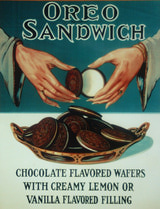 Oreos and Aunt Jemima syrup. Cereal was one of the first widely marketed “health foods”. In its original form the first cereal was made with a grain like wheat or rice and was similar to a corn flake with no added sugars. One of the major driving forces for ready-to-cook foods was war time. In conjunction with World War I canned and frozen foods became popular. Shortly thereafter processed foods began to take over the nations diet. Spam gained popularity because it was a perfect item to feed troops. More than 100 million pounds of SPAM luncheon meat are shipped abroad to feed allied troops during World War II. After World War II there was an increase in the supply of processed food items, therefore marketers needed to make a demand. Military research had brought about many new “convenience foods” like dehydrated juice and cake mix.
Oreos and Aunt Jemima syrup. Cereal was one of the first widely marketed “health foods”. In its original form the first cereal was made with a grain like wheat or rice and was similar to a corn flake with no added sugars. One of the major driving forces for ready-to-cook foods was war time. In conjunction with World War I canned and frozen foods became popular. Shortly thereafter processed foods began to take over the nations diet. Spam gained popularity because it was a perfect item to feed troops. More than 100 million pounds of SPAM luncheon meat are shipped abroad to feed allied troops during World War II. After World War II there was an increase in the supply of processed food items, therefore marketers needed to make a demand. Military research had brought about many new “convenience foods” like dehydrated juice and cake mix.
These new ways of preparing food was advertised to women as a means of liberating them from the kitchen, saving them time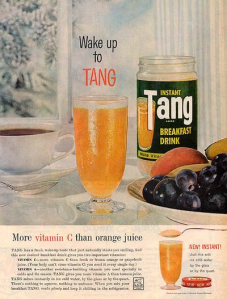 and giving them freedom to get out of the kitchen. By the 1960’s televisions and microwaves become popular and were found in many American homes. Products like Swanson TV dinners started to emerge alongside the rise of fast food restaurants. The amount of food dollars that were spent outside of the home rose sharply in the 1970s when more women joined the work force.
and giving them freedom to get out of the kitchen. By the 1960’s televisions and microwaves become popular and were found in many American homes. Products like Swanson TV dinners started to emerge alongside the rise of fast food restaurants. The amount of food dollars that were spent outside of the home rose sharply in the 1970s when more women joined the work force.
The 1990 Nutrition Labeling and Education Act (NLEA) required that all packaged foods include standard nutrition labeling information. The 1990’s also saw the mass consumption of caloric sweeteners.
The increasing amounts of meals that Americans ate from fast food restaurants and premade meals wreaked havoc on their waistlines. As response to this manufactures came out with new formulated products that were “low-fat,” “fat-free” and diet. The creation of low fat product lines was more about getting consumers to keep buying products and less about their health. Fat content was reduced by removing high-fat ingredients but the products still needed to taste good so artificial flavors and sweeteners were added in order to counterbalance the change as well as preservatives to extend shelve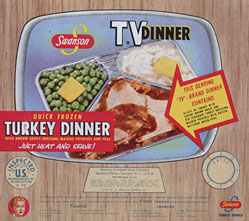 lives.
lives.
The amount of new food products, in 2000, that were marked “reduced/low fat” was 2,076 out of 16,890. Which had been a peak at the time. In the past years, marketers have become increasingly likely to make heavy use of nutrition claims (including “low fat”), health claims, and vague unregulated claims or health sales (“smart choice” or “good for you”).
In 2007 the recession had caused many people to begin to cook more foods at home and eat out less often. There is a growing concern about nutrition. About 80% of meals were prepared at home in November 2013, about the same as 2012, NPD data show. The percentage of meals prepared at home has risen steadily from 77.4% in 2008 at the beginning of the recession. Consumers want more health food items conveniently available to them. Popular movements such as the organic movement have caused consumers to question how and what our food is made of.
As an outcome of these movements “processed food” has become synonymous with unhealthy. But processed foods should not holistically be seen as bad. Products that are canned, frozen, or pasteurized can be very health. By freezing vegetables farmers are able to harvest them at their peak and we can have a consistent supply of fresh vegetables. There are also products that need to be processed for human consumption like oatmeal and coco-beans.
Studio Tours
- I was first drawn to Katie’s project because I felt like I could gain knowledge from her posts. Many people have disabilities and I know that I have a lack of understanding about many disabilities when they should be something I am more aware. Blogs are a great space to share knowledge and Katie used her blog well to do that. Katie pointed out that every 1 in 4 people has a mental illness, so it safe to assume that we all know someone with one. With so many people living with mental illnesses it would be good for society to be more aware and understanding of how mental illnesses affect those who have one as others. I really like the additional media that she adds like images and videos. By talking about the disability and the sharing the story of well known celebrity Katie is able to relate to the reader and emphasizes her point that disabilities don’t need to hold people back.
- Movies play a role in society they are frequently apart of our lives. Personally I love learning about new things. Jennifers project interested me because I would like to know more about movies like the score, types of shots, and so on. Her blog has many topics that cover everything movie related including actors, directors, movie reviews, animation and more. I like the informative way in which she writes. The blog itself is very engaging and easy to navigate. Overall I enjoy Jennifer’s blog and find the topics that she writes about to be quite interesting.
- For Ambers project on alternative fashion it seems fitting that shes uses a wiki since the content is informative and describes the various types of fashions and this also allows others to contribute. Her page is to be used as a source of information and I think she executes this well. I had seen the style lolita before and never had really thought much about it besides it being a Japanese style. It was cool learning about why people started doing it and how others use it her in America. Fashion is such an integral part of how we express ourselves, by learning about where trends came from and what they mean to the people that take part in them we can learn more about that person. Amber’s wiki page was very well put together and I enjoyed the videos she used.
The Components of a Healthy Salad and What to Avoid
We classify food as either healthy or unhealthy and salad has always been known as healthy. When eating out or grabbing a quick lunch pre-made salads appear to be a healthy option. Be sure to selective when ordering a salad. Quite often the nutrtion content of salads end out being approximately the same as a burger alternative. The goal of the restaurant is to make tasty food that you will order again, so they added on indulgent ingredients like fatty dressings, cheese, and croutons. In order to make a salad a well rounded meal one usually adds protein, when restaurants do this they usually add crispy chicken which quickly adds calories.
A 2012 study, which found that although fast food menus grew between 1996 and 2010 to include 53 percent more dishes and snacks, the average number of calories in each item hadn’t changed.
“Entree salads, which are increasing in number, can be bad, too. With fried chicken on top and regular dressing, they can have more calories than a burger,” lead researcher Katherine Bauer, an assistant professor in the department of public health at Temple University, told HealthDay at the time of the study’s release.
Salads can be very nutritious depending on how you build yours. In order to get the most out of your meal there are some few ingredients you should be sure to add, and others to stay away from. First off get the most out of the base of your salad by choosing a good dark green. There are many options out there that provide far more nutrients than watery ice berg like kale, spinach and romaine. One can never have too many veggies, well technically maybe they could but it would be really hard, broccoli, peppers, carrots, peas, cucumbers and many more are great additions. Raw veggies are great because they are low in calories, high in nutrients and water content. Since their calories are so low you can pile them on sky high. Protein is a must not matter the source. Options vary from lean meat like chicken, hard boiled eggs, beans, or tofu. Get an extra bonus of omega-3s from tuna or salmon. Please try to resists the bacon bits. Healthy fats are also great in salads. Go for some toasted walnuts, sliced almonds, sunflower seeds or a bit of avocado. Finally there is the dressing, this is usually what makes or breaks a healthy salad. Vinaigrette are a great option, or something with an oil base. In order to have control over how much dressing you add try to order dressing on the side at restaurants so you can keep an eye on how much you use.
Breakfast wars
Taco Bell has gone all-out advertising their new breakfast line up. They have been working on its morning menu of, waffle tacos for over seven years. The shots between McDonalds and Taco Bell have been dubbed the ‘Breakfast War’.
Advertisements of Taco Bell have been specifically aimed at McDonald’s. One video was about a many who had been eating the Egg Muffin since 1984. Another ad showed 25 men from across the country named “Ronald McDonald” who say they “love Taco bell’s new breakfast”.
In response to Taco Bells attacks the golden arches posted this photo and offered free small cups of McCafe coffee to customers during breakfast hours for two weeks. One of them says, “Nothing beats the original #FirstMeal” attached with a picture of an Egg McMuffin, McCafe coffee and hash brown from McDonald’s. This new advertisement, titled Get With The Times, features a man singing about how dull and dated McDonald’s breakfast is to the tune of “Old MacDonald Had A Farm.”
McDonald’s gets about 20 percent of its sales from breakfast. It made $10 billion last year off their morning menu alone, dwarfing Taco Bell’s $7.6 billion in total sales for all menus combined.
“Traffic during the breakfast [hours] have been steadily increasing, while traffic during the lunch and dinner hours have been steadily decreasing year over year, and that’s why there’s this sudden interest in breakfast.” said Haley Peterson, a retail reporter for Business Insider.
